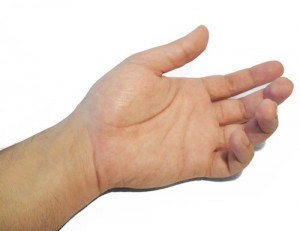
What is Dupuytren’s disease?
Dupuytren’s (pronounced “duh-pwee-trahns”) disease changes the way your hand looks and makes it impossible to use one or more of your fingers. With Dupuytren’s contracture the tissue under the skin of the palm of your hand thickens and becomes shorter.
This leads to the fingers bending in toward the palm and it becomes difficult to straighten them. This condition occurs more in people who are older than fifty years and is more common in men.
Dupuytren’s disease, sometimes referred to as Viking’s disease often affects both hands, too. Our orthopedic specialists can treat this condition but there is no cure for it.
What causes Dupuytren’s disease?
The cause of Dupuytren’s disease is not known. What doctors do know is that it is not caused by an injury or heavy hand usage. Some experts believe it is inherited because the condition tends to run in families. The thickening of the tissue is thought to be related to diabetes, alcoholism, and/or smoking. Certain factors put people at greater risk for developing Dupuytren’s disease. These include:
- It is most common in people of Northern European or Scandinavian ancestry.
- It often runs in families (genetics).
- It may be associated with drinking alcohol.
- It increases in frequency with age.
- It is associated with certain medical conditions, such as diabetes and seizures.
What are the symptoms of Dupuytren’s contracture?
Dupuytren’s contracture progresses slowly and does not cause any pain. The first thing you may notice is a small lump in the palm of your hand, usually near where your ring finger and small finger meet. As the disease worsens, a fibrous cord may develop along the tissue of your palm.
This cord could extend to one or more fingers and pull your finger toward your palm. This is why it is called Dupuytren’s contracture because the fingers contract up. As the disease progresses, you may not be able to flatten your hand on a table or manually push your fingers back. This makes it difficult to put on gloves, pick up things, or wash your hands.
How is Dupuytren’s Disease diagnosed?
Basically, our doctor diagnoses this condition based on the clinical appearance of your hand and your symptoms. They will look for any skin changes on your palm and feel for a cord or any lumps. You will be asked to move your hand, fingers, and wrist and he will attempt to move them. He will ask you about injury, trauma, smoking, alcohol use, diabetes, and family history.
How is Dupuytren’s Contracture treated?
Unfortunatly, there is little therapy that is proven to provide significant improvement in the contracture associated with Dupuytrens.
There are two in-office procedures that are quite successful for many cases of dupuytrens contracture. The first is Xiaflex injections, which are a collagenase that breaks down the dupuytrens cords. The sequence is that the cord is injected on one office visit, requiring a visit 24 hours later to manipulate the finger straight.
Many patients have very good success with getting their hands straight even with severe contractures. The medication is usually covered by insurance, but is fairly expensive right now, usually requiring pre-approval.
The second in-office procedure that is quite successful in carefully selected situations is the Needle Aponeurotomy procedure (NA). This is a one-visit procedure which allows for the cords to be transected with a needle in the office, often producing dramatic resolution of the long-standing contracture.
The procedure is relatively painless and the relief of the deformity is quite good. The lasting effects of the Xiaflex injections or the Needle Aponeurotomy procedures is about 3 years on average.
It is important to remember that with any procedure, Dupuytrens is treated, but not eliminated.
Surgery may be recommended if the deformity is severe and there is significant joint contractures. This woud be determined at a consultation by one of our hand orthopedic specialists, Dr Wayne Weil or Dr Scott Ruhlman. In the procedure, the cord is excized and the joint released along with rearranging the skin on the palm of the hand to provide full extension.
Typically there is therapy required for about 4-6 weeks to maintain the results of the surgery. Typically, most patients see at least 5 years of relief, if not more, from the surgical excision.
Find OSS on Facebook and follow on Twitter to keep up to date on new articles and news.

